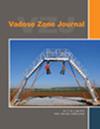从机理上推导出的宏观根系吸水函数:根系吸水函数的 α 和 ω
IF 2.8
3区 地球科学
Q3 ENVIRONMENTAL SCIENCES
引用次数: 0
摘要
植物根系的水分吸收是土壤水分平衡的重要组成部分。预测树冠的潜在蒸腾量(即蒸腾需求量)在多大程度上可以通过根系从土壤中获得水分供应,对于模拟实际蒸腾量和评估植被水分胁迫至关重要。在模拟作为水通量和土壤水势梯度函数的垂直土壤含水量剖面动态的模型中,根系吸水(RWU)分布由宏观汇项表示。我们提出了基于土壤-根系水流机理模型计算汇项的 RWU 函数。根据土壤-根系水力学,我们定义了 α 供水函数,表示当根领水势等于枯萎点时根系从某一土壤深度的最大吸收量;ω 供水因子,表示整个根系的最大供水量;临界 ωc 因子,表示潜在的蒸腾需求量。这些函数和因子随后可用于直接根据潜在蒸腾或需求量和土壤水势计算 RWU 分布。目前使用的方法定义了代表实际吸收量与吸收需求量之比的α-应力函数和ω系数,而基于供给的公式则不同,它可以直接从土壤和根系的水力特性中推导出来,并能代表根系水力再分配和水力提升等过程。本文章由计算机程序翻译,如有差异,请以英文原文为准。
Mechanistically derived macroscopic root water uptake functions: The α and ω of root water uptake functions
Water uptake by plant roots is an important component of the soil water balance. Predicting to what extent potential transpiration from the canopy, that is, transpiration demand, can be met by supply of water from the soil through the root system is crucial to simulate the actual transpiration and assess vegetation water stress. In models that simulate the dynamics of vertical soil water content profiles as a function of water fluxes and soil water potential gradients, the root water uptake (RWU) distribution is represented by macroscopic sink terms. We present RWU functions that calculate sink terms based on a mechanistic model of water flow in the soil–root system. Based on soil–root hydraulics, we define α ‐supply functions representing the maximal uptake by the root system from a certain soil depth when the root collar water potential equals the wilting point, ω ‐supply factors representing the maximal supply from the entire root system, and a critical ωc factor representing the potential transpiration demand. These functions and factors are subsequently used to calculate RWU distributions directly from potential transpiration or demand and the soil water potentials. Unlike currently used approaches, which define α ‐stress functions and ω factors representing ratios of actual uptake to uptake demand, the supply‐based formulations can be derived directly from soil and root hydraulic properties and can represent processes like root hydraulic redistribution and hydraulic lift.
求助全文
通过发布文献求助,成功后即可免费获取论文全文。
去求助
来源期刊

Vadose Zone Journal
环境科学-环境科学
CiteScore
5.60
自引率
7.10%
发文量
61
审稿时长
3.8 months
期刊介绍:
Vadose Zone Journal is a unique publication outlet for interdisciplinary research and assessment of the vadose zone, the portion of the Critical Zone that comprises the Earth’s critical living surface down to groundwater. It is a peer-reviewed, international journal publishing reviews, original research, and special sections across a wide range of disciplines. Vadose Zone Journal reports fundamental and applied research from disciplinary and multidisciplinary investigations, including assessment and policy analyses, of the mostly unsaturated zone between the soil surface and the groundwater table. The goal is to disseminate information to facilitate science-based decision-making and sustainable management of the vadose zone. Examples of topic areas suitable for VZJ are variably saturated fluid flow, heat and solute transport in granular and fractured media, flow processes in the capillary fringe at or near the water table, water table management, regional and global climate change impacts on the vadose zone, carbon sequestration, design and performance of waste disposal facilities, long-term stewardship of contaminated sites in the vadose zone, biogeochemical transformation processes, microbial processes in shallow and deep formations, bioremediation, and the fate and transport of radionuclides, inorganic and organic chemicals, colloids, viruses, and microorganisms. Articles in VZJ also address yet-to-be-resolved issues, such as how to quantify heterogeneity of subsurface processes and properties, and how to couple physical, chemical, and biological processes across a range of spatial scales from the molecular to the global.
 求助内容:
求助内容: 应助结果提醒方式:
应助结果提醒方式:


